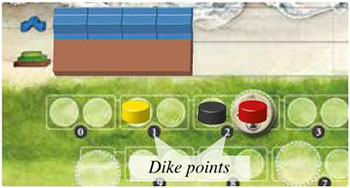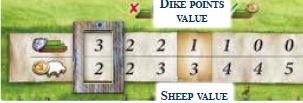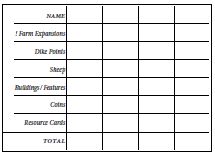
On the wave-battered coast of the North Sea, hard-working folk make a living by the sweat of their brow. Under constant threat of storm and flood, communities rally together to build dikes that keep the rising tide at bay.
But every citizen constructing a dike is one fewer citizen tending flocks and maintaining the family farm. The residents are torn between selflessness and self-interest, and only those who can strike this delicate balance can thrive in the harsh landscape.
Components
Shared Components

- 1 Main Board
- 2 Sheep Market Boards
- 3 Resource Markers
- 85
- 6 3-sheep Tokens
- 64 Fences
- 1 Phase Marker
- 12 Flood Cards
- 66 Resource Cards
- 1 First Player Marker
- 36 Flood Pieces
- 13 Dike Segments
- 5 Progress Tokens
- 1 Value Marker
- 30 Dike Breach Tokens
- 53 Coins
- 4 Farmer +2 Tokens
- 1 Sticker Sheet
- 1 Scorepad
- 1 Appendix
- 46 Farm Expansion Tiles:
- 12 Sheep Buildings
- 6 Storm Surge Buildings
Player Components (1 Set Per Player)
- 1 Farmyard Board
- 1 Income Board
- 2 Laborers
- 1 Reference Sheet
- 1 Dike Point Marker
- 3 Farmers
- 4 Building Markers
Object of the Game
The winner in Lowlands will be the player who scores the most victory points (VP). Housing sheep and building the dike will both provide VP, though their values will change over the course of the game.
The changing values are shown on the value track on the main board. You will also get VP for coins (1 VP per coin), remaining resource cards (1 VP per two cards), and the farm expansions you build over the course of the game (VP shown on tile).
Setup - Shared

1 Place the main board in the middle of the table.

2 Shuffle all the flood cards together and place them facedown on the shown space of the main board to create the flood deck. Note: For your first game, return the flood card showing "6" to the box before creating the deck.

3 Each player chooses a color. Stack the dike point markers of the chosen colors in a random order on the first space of the dike track (0 dike points). Return any unused dike point markers to the box.

4 Randomly place one progress token faceup on each of the the first five large spaces of the dike track.
5 Place the value marker on the middle space of the value track.

6 Place the phase marker on the first space of the phase track ("Turn of the Tide" O).

7 Shuffle the resource cards and place them facedown on the shown space of the main board to create the resource deck. Draw four cards and place them faceup on different spaces of the resource display.
8 Place the sheep market board that matches the number of players (shown by a number of dots in the top-right) next to the game board.

9 Place the three resource markers on the shown spaces on the sheep market board.

10 Place one sheep on each space of the sheep market board showing a sheep icon. Return the other sheep market board to the box.
11 Sort the farm expansion tiles (buildings and features) into four stacks according to their backs. Shuffle each stack separately and place the stacks next to the main board.
Draw three tiles each from the feature, sheep building, and action building stacks and place them faceup in columns below their respective stacks.
Draw storm surge tiles equal to the number of players plus one and place them faceup in a column next to the other columns. Return the remaining storm storm surge tiles to the box; they will not be used this game.

12 Place all coins, sheep, 3-sheep tokens, flood pieces, dike segments, dike breach tokens, and farmer +2 tokens near the board as a supply. Set the scorepad aside; you will not need it until the storm surge phase.
Setup (player)
Each player gathers the following components:
- 1 income board
- 1 reference sheet
- 3 farmers of your chosen color (values 2, 3, and 4)
- 4 building markers of your chosen
- 2 sheep
- 16 fences
- 2 laborers
- 4 coins
- 4 resource cards comprising your hand (hidden from other players)
Place your farmyard board in front of you with the side of your choice faceup (both sides have the same layout). Then place your income board and reference sheet faceup next to your farmyard board, and keep your coins and farmers near your farmyard board.
Return all unused farmyard boards, income boards, reference sheets, farmers, building markers, fences, and laborers to the box.
Place your gathered components on your farmyard and income boards as shown:


The player whose dike point marker is on top of the stack is the first player and takes the first player marker. Each other player gains one coin from the supply.
Game Play

The game is divided into phases that are grouped into three stages.
Each of the three stages consists of six phases resolved in the following order:

The position of the phase marker indicates the current phase. At the end of each phase, move the phase marker up one space to the next phase.
After playing through all three stages, you will resolve one final phase: the storm surge phase.
You begin the game with the first f Turn of the Tide phase.
 Turn Of The Tide
Turn Of The Tide
-
Check hand size: Each player with more than eight resource cards in hand chooses and discards cards until he has eight cards.

-
Place 3 new flood cards: Draw three flood cards from the flood deck and place one facedown on each of the three sea spaces on the main board.

-
Reveal new flood card: Flip over the leftmost facedown flood card on a sea space. Take the number of flood pieces shown on the front of the card and place them from left to right on empty flood spaces on the main board as a first level.
After you finish a level (12 flood pieces), stack further flood pieces from left to right on top of the previous level as a new level. Over the course of the game the flood will rise three levels high.

The flipped flood card shows a value of three, so three flood pieces are placed on flood spaces on the main board.
The back of each flood card shows the range of possible values for that card:
 The front of this card will show a value between 1 and 3.
The front of this card will show a value between 1 and 3.
 The front of this card will show a value between 4 and 6.
The front of this card will show a value between 4 and 6.
 Work Phase
Work Phase
During the I Work phase, you place your farmers on spaces to take actions. When you place a farmer on a space, you gain action points equal to the farmer's action value (2, 3, or 4) which you spend to resolve the actions.

Starting with the first player and proceeding clockwise, players take turns placing one of their unplaced farmers on an action space on their own farmyard board and resolving the corresponding action. Players continue taking turns in this order until all farmers have been placed.
You can place a farmer on one of your action spaces that already contains one or more farmers; to do so, pay one coin to the supply if there is one farmer already on the space or two coins if there are already two farmers. If you cannot pay the cost, you cannot place the farmer on that space and take that action.
The following rules apply to all actions:
-
Resource Substitution: You can always pay two resources of one type instead of paying one resource of another type. The Carpenter's Workshop, Bricklayer's Workshop, and Stonemason's Workshop buildings do not affect this payment. To pay resources, discard them from your hand and place them faceup in the resource discard pile.

-
Laborers: While assigned to an action, laborers improve that action for you. The different effects of laborers on each action are explained below each action's description.
Whenever you uncover a laborer icon on your income board or reach the progress token showing; a laborer icon on the dike track, you may either assign a laborer on your income board to an action on your farmyard board or move one of your assigned laborers from one action to another on your farmyard board.
Up to two laborers can be assigned to each action except the "buy or sell sheep" action, which can have only one.

-
Unused Action Points: After taking an action, if you did not spend all your available action points (including any additional action points from laborers), you may spend unused points to draw resource cards at a cost of one action point per card and add them to your hand.
Draw these cards following the same rules as the "draw resource cards" action. You cannot skip an action to save the action points for drawing cards.

-
Component Limitations: If you would draw a card from the resource deck and the deck is empty, shuffle the resource discard pile and place it facedown on the main board to create a new resource deck.
Sheep, coins, and dike breach tokens are unlimited; if you run out of any of these components, use a substitute. You can use 3-sheep tokens in place of three individual sheep.

 Upkeep
Upkeep
During the II Upkeep:) phase, resolve the following steps:
-
Breeding: For every two sheep housed on your farmyard board, take one shee p from the supply and house it on your board if able.

-
Income: Starting with the first player and proceeding; clockwise, each player gains any income visible on his or her income board.
Each player will draw at least one resource card as income (shown by the income icon on the top-right of the income board); additional income can be uncovered by building fences and buildings.
 Draw one card from the resource deck
Draw one card from the resource deck Gain one coin.
Gain one coin. Draw one card from the resource deck or Gaine one coin.
Draw one card from the resource deck or Gaine one coin. -
Retrieve farmers: Remove all your farmers from action spaces and keep them near your farmyard board.

-
Reset sheep market: Return all sheep on the sheep market to the supply, then place one sheep from the supply on each space of the sheep market showing a sheep icon.
-

Change first player: The player who is furthest along the dike track becomes the first player and takes the first player marker. If multiple players are tied for furthest, the tied player whose dike point marker is on top becomes the first player.
-

Reveal new flood card: Flip over the leftmost facedown flood card on a sea space. Take the number of flood pieces shown on the front of the card and place them from left to right on empty flood spaces on the main board as a first level.
After you finish a level (12 flood pieces), stack further flood pieces from left to right on top of the previous level as a new level. Over the course of the game the flood will rise three levels high.
During the last II Upkeep phase of the game, resolve steps 1, 2, and 6, skipping 3, 4, and 5.
Housing Sheep

Each space on your farmyard board that is within a pasture (enclosed by fences and/or buildings) can house one sheep.
Some farm expansions change this rule, and others allow you to house sheep on the tile itself. Unless indicated otherwise, you cannot house sheep on farm expansion tiles.
At any time, you can move your sheep between spaces within pastures and farm expansions that can house sheep (for example, if you want to build a farm expansion on a space housing a sheep, you will have to move that sheep).
You cannot return a sheep from a space to the supply unless an action or effect allows you to do so. If you would gain a sheep and could not house it, you do not gain that sheep.
 High Tide
High Tide
During this phase, you will check whether the dike breaks or holds.
Check the dike: Compare the level of the flood pieces with the level of the dike segments:
- If the dike level is higher than the flood level, the dike holds.
- If the flood level is higher than the dike level, the dike breaks.
If the levels are equal, compare the row of flood pieces on the highest level with the row of dike segments on the highest level:
- If the row of dike segments is longer than the row of flood pieces, or if the lengths are equal, the dike holds.
- If the row of flood pieces is longer than the row of dike segments, the dike breaks.
Resolve the corresponding effect, then return the three flood cards on flood spaces to the box.

Dike holds: Each player gains one coin for each dike point he has more than the player with the fewest dike points; dike points are shown under each pair of spaces on the dike track (the player with the fewest dike points does not gain any coins).
Then move the value marker one space to the right on the value track.

The lengths of the rows of flood pieces and dike segments are equal, so the dike holds. Sue and Joe both have two dike points, which is one more than John.
Sue and Joe each gain one coin. John has contributed the least to the dike and gains no coins.

Dike breaks: Each player gains one dike breach token for each dike point he has fewer than the player with the most dike points (the player with the most dike points does not gain any dike breach tokens).
Then move the value marker one space to the left on the value track.
(Pastures begin flooding and farmers cannot house all of their sheep, so they begin selling them off. Due to the large supply, the value of sheep decreases).
 Storm Surge
Storm Surge
-
Score buildings and features with
 : Resolve the effects of each farm expansion showing a "!" icon. Note any VP gained this way in the "! farm expansions" section of the scorepad.
: Resolve the effects of each farm expansion showing a "!" icon. Note any VP gained this way in the "! farm expansions" section of the scorepad. -

Check the dike: Check the dike as before, but resolve the following effects instead of the normal result:
Dike holds: All players discard all dike breach tokens to the supply without effect.
Dike breaks: Each player discards one sheep to the supply for each of his or her dike breach tokens. If any player does not have enough sheep, he pays coins equal to the current value of sheep for each sheep he is short.
If he does not: have enough coins, he loses one VP for each coin he is short. Note these negative VP in the "Coins" section of the scorepad.

-
Final scoring: Score VP as follows and note them on the scorepad:
Dike points: For each of your dike points, gain VP equal to the current value of dike points; the value of dike points is shown on the top row of the value track (if you advanced past the last space on the dike track, add 20 to your dike points).
Sheep: For each of your sheep, gain VP equal to the current value of sheep.

Buildings and features: Gain the VP shown on the shield icons on your farm expansions (
 ).
).Coins: Gain 1 VP for each of your coins.

Resource cards: Gain 1 VP for every two resource cards in your hand.
End of the Game

The game ends at the end of the storm surge phase. The player with the most VP wins the game!
In the case of a tie, the tied player who is furthest on the dike track wins the game. If there is still a tie, the tied player whose dike point marker is on top wins the game.
Rule Changes for 2 Players
The game plays the same with two players as it does with three or four players, with one exception:
After completing the "contribute to the dike" action, you may pay one coin to ask the market for help instead of asking an opponent for help. If you cannot pay the coin, you must ask your opponent for help.
If you ask the market for help, one at a time, reveal as many resource cards from the top of the resource deck as you paid to construct dike segments during your action.
For each resource card you reveal that could be used to contruct a dike segment, advance the matching resource marker one space on the construction yard track.
If a dike segment is completed before you have finished revealing cards, continue revealing cards and begin constructing the next dike segment with the next different resource card you reveal. Then discard all cards revealed this way.
Note: You do not advance an additional space on the dike track when asking the market for help.
Continue Reading
